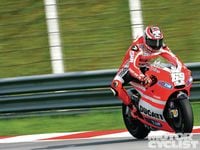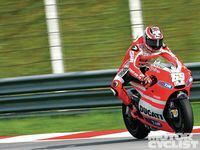Barring a few exceptions, the front wheel of your motorcycle is steered and suspended by a telescopic fork. Steering motion is a simple rotation around the steering axis, and suspension motion an equally simple sliding motion between two pairs of tubes.
That’s not to say that the forces and mechanisms involved are necessarily simple. Steering motion is constrained by steering geometry; by the forces generated from the rotation of the front tire, wheel and brakes; by the complex interactions of the tire against the pavement; and even by the rider’s hands in contact with the handlebar. To further complicate things, the steering motion can sometimes be damped by a hydraulic steering damper.
The suspension motion is controlled by springs that support the weight of the motorcycle, dampers that in turn control the spring motion, bushings that reduce friction to ease the sliding motion and oil to lubricate it all.
These two motions are so much a part of riding that we don’t think about them much. If they come to our attention at all, it’s probably because we’re experiencing problems: headshake or wobble in steering motion, or loss of traction over rough pavement.
But there is a third motion that isn’t talked about much. Though there are springs inside the fork, the fork itself is also a spring. It allows the axle to move back and forth, perpendicular to the fork’s sliding axis (and, to a lesser extent, side-to-side), because the fork tubes flex under load, bending as load conditions change. And this flexing and recovering motion is not damped. The extent of flex is controlled by the strength of the components, but the movement itself is not controlled.
Ride an unfaired vintage bike and look down at the front axle: It buzzes back and forth perceptibly. Newer forks do a better job, but still show some movement, although rarely enough to matter. As speeds and the forces generated by speed increase, however, the third motion of your fork might not be so innocent.
Under heavy braking, where the rear suspension extends to the point that the rear tire literally lifts off the ground, the fork sees its highest loading. In that situation, the entire weight of the bike and rider is trying to bend the fork back toward the engine. That’s at 1G (1 x the force of gravity) braking. Add carbon brakes and exceptional tires, as in MotoGP, and braking forces may rise to 2G.
Anecdotal evidence from an AMA Superbike team sheds light on this third motion. Their bike’s front tire cleared the radiator under full suspension compression in the garage, but on the racetrack the tire contacted the radiator to the point that they had to move the radiator back more than 25mm. That’s an inch of flex.
As a bike enters a corner under braking, with the front suspension fully compressed and the rear wheel an inch off the ground, the trail measurement might be reduced from 100mm to about 70mm. Reducing trail generally reduces stability, so the bike may become unstable at a 30 percent reduction in trail. Ironically, fork flex comes to our assistance now, because if the fork flexes back 20mm, that adds 20mm of trail, giving us 90mm for better stability.
Let off the brakes and the fork can spring back over center, reducing trail. It can get pretty complex, mounting your front wheel on the end of a spring. In my view, a basic reason to have flex in the frame, and to work on tuning flex, is to provide some way of damping the third motion inherent in the fork. Compared to the fork, the typical aluminum frame is a relatively “soft” structure in which some of the energy imparted by fork flex and rebound can be dissipated as it travels through the frame members.
The MotoGP Ducati’s troubles with steering feel may be attributable to the fact that its steering-head structure is a short box which, being much stiffer than an aluminum beam frame, is unable to dissipate this fork-flex energy. Making the box from aluminum rather than carbon-fiber might not make much difference, as the box is stiff from its shape and size, regardless of material.
The telescopic fork is simple in concept but hardly simple in the details of its motions. The third motion, in particular, presents a complex mystery as the fork is pushed to its maximum performance limits.













/cloudfront-us-east-1.images.arcpublishing.com/octane/HXOUJXQWA5HBHGRO3EMJIGFMVI.jpg)

/cloudfront-us-east-1.images.arcpublishing.com/octane/3TIWWRV4JBBOLDVGRYECVVTA7Y.jpg)
/cloudfront-us-east-1.images.arcpublishing.com/octane/KIX5O23D5NAIBGFXBN3327DKZU.jpg)
/cloudfront-us-east-1.images.arcpublishing.com/octane/7GJYDUIPXRGMTMQKN6ONYOLBOU.jpg)
/cloudfront-us-east-1.images.arcpublishing.com/octane/MUQLOVLL2ZDGFH25ILABNBXKTI.jpg)
/cloudfront-us-east-1.images.arcpublishing.com/octane/TNOU5DNE2BC57MFPMGN2EIDXAM.jpg)
/cloudfront-us-east-1.images.arcpublishing.com/octane/GTCXACQGJ5HAPDTGWUQKDEH44E.jpg)
/cloudfront-us-east-1.images.arcpublishing.com/octane/S35YGSEMEZB4BLTDJTSZPF4GLA.jpg)
/cloudfront-us-east-1.images.arcpublishing.com/octane/5UOT6HPX2JFMRJAX6EH45AR4MQ.jpg)
/cloudfront-us-east-1.images.arcpublishing.com/octane/OKWOJWAKP5EP3OACCRRWPCIX2Q.jpg)
/cloudfront-us-east-1.images.arcpublishing.com/octane/2WF3SCE3NFBQXLDNJM7KMXA45E.jpg)
/cloudfront-us-east-1.images.arcpublishing.com/octane/G4MG6OUCJNBSHIS2MVVOTPX65E.jpg)
/cloudfront-us-east-1.images.arcpublishing.com/octane/IIGGWFOTOJGB7DB6DGBXCCMTDY.jpg)
/cloudfront-us-east-1.images.arcpublishing.com/octane/QSTCM6AVEZA5JJBUXNIQ3DSOF4.jpg)
/cloudfront-us-east-1.images.arcpublishing.com/octane/U4I7G625B5DMLF2DVIJDFZVV6M.jpg)
/cloudfront-us-east-1.images.arcpublishing.com/octane/B6XD6LS6IVCQPIU6HXDJSM3FHY.jpg)
/cloudfront-us-east-1.images.arcpublishing.com/octane/ICL63FEDDRDTTMINYICCEYGMDA.jpg)
/cloudfront-us-east-1.images.arcpublishing.com/octane/FCGZHQXRBZFLBAPC5SDIQLVF4I.jpg)
/cloudfront-us-east-1.images.arcpublishing.com/octane/WNOB6LDOIFFHJKPSVIWDYUGOPM.jpg)

/cloudfront-us-east-1.images.arcpublishing.com/octane/X33NU3E525ECRHXLNUJN2FTRKI.jpg)
/cloudfront-us-east-1.images.arcpublishing.com/octane/6KKT5NNL2JAVBOXMZYS5ZO76YA.jpg)
/cloudfront-us-east-1.images.arcpublishing.com/octane/J5RKG5O455GMPGQRF2OG6LRT7A.jpg)